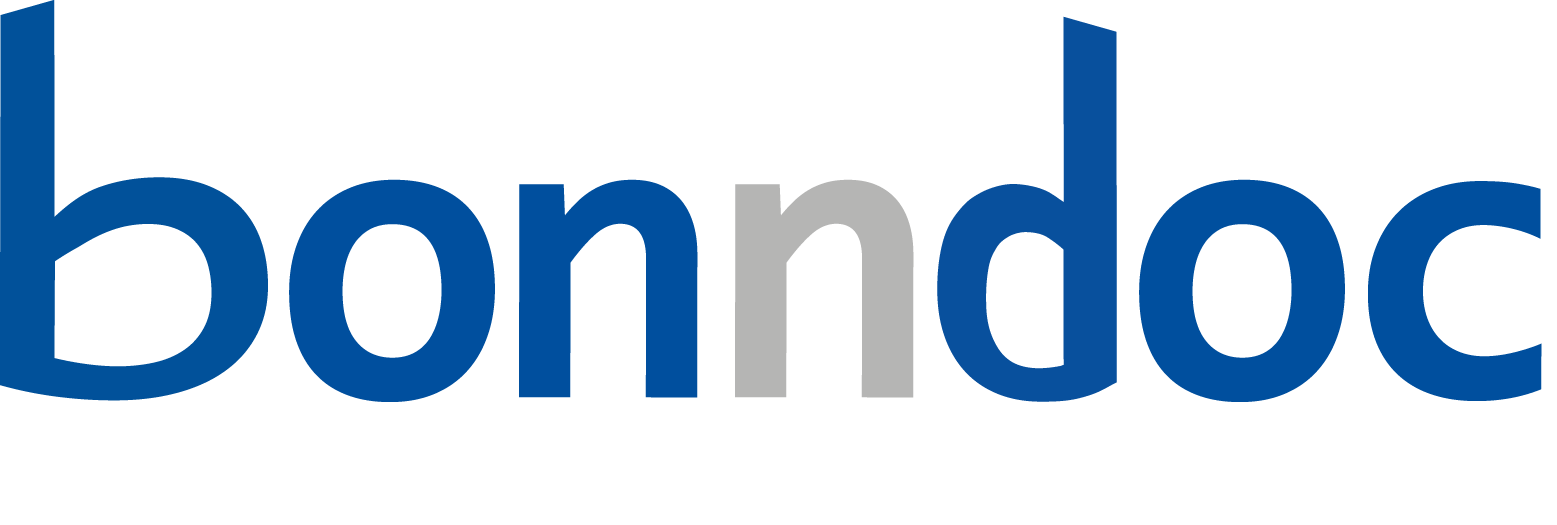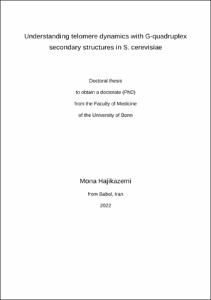Hajikazemi, Mona: Understanding telomere dynamics with G-quadruplex secondary structures in S. cerevisiae. - Bonn, 2022. - Dissertation, Rheinische Friedrich-Wilhelms-Universität Bonn.
Online-Ausgabe in bonndoc: https://nbn-resolving.org/urn:nbn:de:hbz:5-65800
Online-Ausgabe in bonndoc: https://nbn-resolving.org/urn:nbn:de:hbz:5-65800
@phdthesis{handle:20.500.11811/9669,
urn: https://nbn-resolving.org/urn:nbn:de:hbz:5-65800,
author = {{Mona Hajikazemi}},
title = {Understanding telomere dynamics with G-quadruplex secondary structures in S. cerevisiae},
school = {Rheinische Friedrich-Wilhelms-Universität Bonn},
year = 2022,
month = mar,
note = {Telomeres are specialized nucleoprotein structures at the end of linear eukaryotic chromosomes, vital for safeguarding of genetic material. They inhibit nucleolytic degradation, end to end fusion and unwanted recombination. The telomerase enzyme impedes telomere shortening, but is not expressed in most somatic cells. On one hand telomerase absence results in telomere shortening, leading to aging. On the other hand telomerase reactivation is a hallmark of many cancer cells. Furthermore, de novo telomere addition to internal regions should be avoided to maintain genome integrity. Eukaryotic cells have developed different regulatory mechanisms to outcompete these challenges. To our knowledge, the destiny of telomerase components and where they are located throughout the cell cycle is not fully understood.
Here, we entailed S. cerevisiae as model organism and identified the genome-wide binding sites of the telomerase catalytic subunit Est2. Specific internal sequences (termed NTBS) showed preference for inactive Est2 binding, when it is not attached to telomeres. 3D conformation of chromosome has been proposed to establish a boundary between Est2 association to telomeres and NTBS.
The terminal part of eukaryotic telomeres contains a single stranded G-overhang, which is capped by telomeric proteins such as Cdc13 in yeast. The G-overhang gets extended in late S phase of the cell cycle. Several lines of evidence have revealed the G-overhang potential for forming non-B DNA structures. We studied the folding kinetics of different oligonucleotides resembling the G-overhang. Here, we revealed that depending on the length, they can form G-quadruplexes (G4) or G-hairpins in vitro. Regardless of their topology, these structures impede Cdc13 binding in vitro. The formation of G4s has been shown to be more likely in late S phase when the overhang is longer. We proposed a model explaining the potential function of non-B DNA structures formed in the G-overhang in a time and length dependant manner.
Despite the rising evidence for G4 functions at telomeres, little is known about their in vivo abundancy, the correlation to telomere length and telomeric proteins. We entailed a previously established method with the help of a G4 specific antibody (BG4) to pull down G4s at yeast telomeres. Here, we show that telomeric G4 landscape at changes throughout the cell cycle. G4 abundancy is generally less at short telomeres, however it does not necessarily depend on telomere length and is more related to the presence of telomeric proteins.
Finally, we characterized the telomeric abundancy of the recently identified G4 stabilizing protein, Zuo1. Despite the G-rich nature of telomeres, the in vivo relevance of G4 formation and the underlying mechanisms at telomeres is poorly understood. Absence of Zuo1 did not show a length effect on telomeres. Zuo1 binding to the studied telomeres changes during the cell cycle and is less abundant in late S phase. Zuo1 binding to telomeres have been increased in the pif1-m2 strain, pointing out it is related to more abundant G4. Furthermore, we reveal Zuo1 interaction with G4 associated telomeric protein Stm1. However the exact underlying mechanism should be further clarified.},
url = {https://hdl.handle.net/20.500.11811/9669}
}
urn: https://nbn-resolving.org/urn:nbn:de:hbz:5-65800,
author = {{Mona Hajikazemi}},
title = {Understanding telomere dynamics with G-quadruplex secondary structures in S. cerevisiae},
school = {Rheinische Friedrich-Wilhelms-Universität Bonn},
year = 2022,
month = mar,
note = {Telomeres are specialized nucleoprotein structures at the end of linear eukaryotic chromosomes, vital for safeguarding of genetic material. They inhibit nucleolytic degradation, end to end fusion and unwanted recombination. The telomerase enzyme impedes telomere shortening, but is not expressed in most somatic cells. On one hand telomerase absence results in telomere shortening, leading to aging. On the other hand telomerase reactivation is a hallmark of many cancer cells. Furthermore, de novo telomere addition to internal regions should be avoided to maintain genome integrity. Eukaryotic cells have developed different regulatory mechanisms to outcompete these challenges. To our knowledge, the destiny of telomerase components and where they are located throughout the cell cycle is not fully understood.
Here, we entailed S. cerevisiae as model organism and identified the genome-wide binding sites of the telomerase catalytic subunit Est2. Specific internal sequences (termed NTBS) showed preference for inactive Est2 binding, when it is not attached to telomeres. 3D conformation of chromosome has been proposed to establish a boundary between Est2 association to telomeres and NTBS.
The terminal part of eukaryotic telomeres contains a single stranded G-overhang, which is capped by telomeric proteins such as Cdc13 in yeast. The G-overhang gets extended in late S phase of the cell cycle. Several lines of evidence have revealed the G-overhang potential for forming non-B DNA structures. We studied the folding kinetics of different oligonucleotides resembling the G-overhang. Here, we revealed that depending on the length, they can form G-quadruplexes (G4) or G-hairpins in vitro. Regardless of their topology, these structures impede Cdc13 binding in vitro. The formation of G4s has been shown to be more likely in late S phase when the overhang is longer. We proposed a model explaining the potential function of non-B DNA structures formed in the G-overhang in a time and length dependant manner.
Despite the rising evidence for G4 functions at telomeres, little is known about their in vivo abundancy, the correlation to telomere length and telomeric proteins. We entailed a previously established method with the help of a G4 specific antibody (BG4) to pull down G4s at yeast telomeres. Here, we show that telomeric G4 landscape at changes throughout the cell cycle. G4 abundancy is generally less at short telomeres, however it does not necessarily depend on telomere length and is more related to the presence of telomeric proteins.
Finally, we characterized the telomeric abundancy of the recently identified G4 stabilizing protein, Zuo1. Despite the G-rich nature of telomeres, the in vivo relevance of G4 formation and the underlying mechanisms at telomeres is poorly understood. Absence of Zuo1 did not show a length effect on telomeres. Zuo1 binding to the studied telomeres changes during the cell cycle and is less abundant in late S phase. Zuo1 binding to telomeres have been increased in the pif1-m2 strain, pointing out it is related to more abundant G4. Furthermore, we reveal Zuo1 interaction with G4 associated telomeric protein Stm1. However the exact underlying mechanism should be further clarified.},
url = {https://hdl.handle.net/20.500.11811/9669}
}






